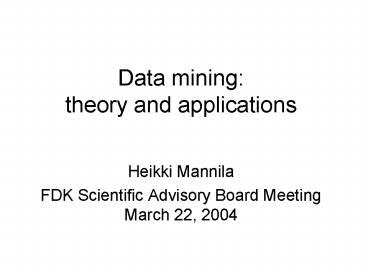Data mining: theory and applications PowerPoint PPT Presentation
1 / 24
Title: Data mining: theory and applications
1
Data mining theory and applications
- Heikki Mannila
- FDK Scientific Advisory Board Meeting March 22,
2004
2
Why?
- Lots of data
- Novel types of data
- Computational techniques gaining in importance
- Algorithmic and probabilistic methods are needed
3
Where is data mining?
- Lots of research since 1993
- Algorithms, databases, pattern recognition,
probabilistic modeling - Early emphasis on scalability and applications
- Current emphasis on applications and solid
frameworks - Data analysis as a major theme in algorithms and
database conferences - Multidisciplinary efforts more common
4
Approach and goals in FDK
- Application area ? concept formation ?
algorithmic question ? algorithm ? analysis ?
back to practice - Algorithmic basic research in areas where the
results can be put into practice - Understanding the fundamental properties of data
summarization and analysis
5
Data mining people
- Loose group structure theory and applications
- 3 seniors (Heikki Mannila, Hannu Toivonen, Jaakko
Hollmén) - 5 postdocs (Bart Goethals, Floris Geerts, Aris
Gionis, Panyoitis Tsaparas, Marko Salmenkivi) - Lots of Ph.D. and M.Sc. students
6
Projects
- CompGenome genome structure
- Gene expression studies (J. Hollmén)
- MobiLife (EU 6th Framework IP)
- April II (STREP)
- Paleoprojects
- Some industrial projects
7
Computational methods
- Pattern discovery
- Finding recurrent patterns in large data sets
- Succinct representations of data
- Combinatorial algorithms
- Dynamic programming, greedy algorithm etc.
- Probabilistic modeling
- Combining pattern discovery, combinatorial
algorithms, and probabilistic modeling
8
Application areas
- Genome structure (Aris Gionis)
- Understanding the types of variation in genomes
(within and between species) - Gene mapping (Hannu Toivonen)
- Gene expression (Jaakko Hollmén)
- Paleontology
- Document data
- Telecommunications data
- Spatial data (onomastics, ecology)
9
Research themes examples
- Finding structure in large 0-1 data sets topic
models, dense itemsets, etc. - Seppänen, Geerts, Goethals, Bingham, Tatti
- Where are the ones in a large 0-1 dataset
- Combining probabilistic and combinatorial methods
- Sequence structure segmentations, vocabularies
- Gionis, Heimonen, Terzi, Kollin
- Discrete algorithms on probabilistic structures
10
Research themes examples
- Pattern discovery
- Goethals, Geerts, Mielikäinen
- Discrete algorithm some probabilistic notions
- Foundations of data analysis
- Seppänen, Goethals, Gionis
- Succinct representations
- Algorithmic aspects of mixture models
- Combining different types of data (sequences,
spatial data, temporal data) - Leino, Salmenkivi, Gionis, Geerts etc.
11
Some examples of themes
- Orders from unordered data
- Fragments of order
- Random walks on databases
12
Orders from unordered data
- Given a 0-1 matrix, can one find some information
about the order of the rows or columns? - Two approaches
- spectral ordering (global total orders)
- fragments of order (local total orders)
13
Example paleontological data
- Given a matrix of occurrences of species in
fossil sites - Ages of the fossil sites are not available
- How to order the sites according to their age?
- Background information species arrive and vanish
- Try to find ordering that minimizes Lazarus
events - species
- A B C
- 0 0 1
- 1 1 0
- 1 0 1
- 0 1 1
- 0 1 0
time
Lazarus events
14
Consecutive ones property
- A matrix has consecutive ones property if rows
can be ordered so that the ones in each column
are consecutive - Consecutive ones property no Lazarus events
- Booth and Lueker 1976 the property can be
decided in linear time - Only for the exact case
15
Computational task
- Find an ordering of the sites that minimizes
Lazarus events - Minimizes deviation from consecutive ones
property - NP-hard
- Good approximation algorithms
16
Spectral ordering
- Let s(i,j) be a similarity measure between sites
- Laplacian matrix L(i,j)
17
Spectral ordering
18
Spectral ordering and consecutive ones property
- Spectral ordering does a good job of
approximating the consecutive ones property
(empirically) - If COP holds, spectral method finds it
- Approximation guarantees no bounds are known
- Practice very good results
- Lots of nice open questions
19
Fortelius, Jernvall, Gionis, Mannila, in
preparation
20
(No Transcript)
21
Fragments of order
- Can we find an order of introduction to
attributes of a 0-1 data set? - database query selectivity
Citeseer - system estimation answers
- 1 1 1 49
- 1 1 0 1930
- 0 1 1 221
- 1 0
1 4 - database system lt query lt selectivity
estimation
22
Fragments of order
- Find all orderings A1 lt A2 lt ...lt Ak among the
attributes such that - There are many rows having at least two 1s in the
columns A1, A2, ..., Ak - There are few rows having the pattern
- Ai ... Aj ... Ak
- 1 ... 0 ... 1
- A levelwise algorithm works fine
23
Random walks on databases
- Random walks on the web very powerful
- What is a random walk on a database?
- State space partial tuples t occurring in the
database - Edges E (t,s) in E if there is a query Q from a
given class such that s is in Q(t) - Ranking of query results etc.
24
Future topics
- Theory and applications of data mining
- Combinatorial algorithms with probabilistic
notions statistics - Foundations algorithmic aspects of mixture
models, condensed representations - Sequences as one unifying topic
- Spatial and spatio-temporal data
- Genome structure what is all the DNA for?
- Linguistic data, process data, paleontological
data, - Postdocs will manage projects

